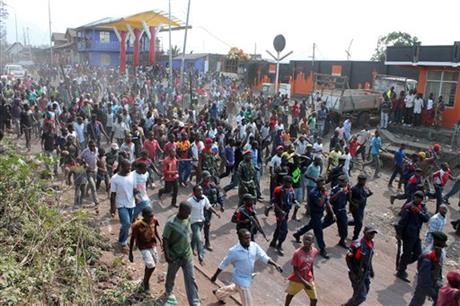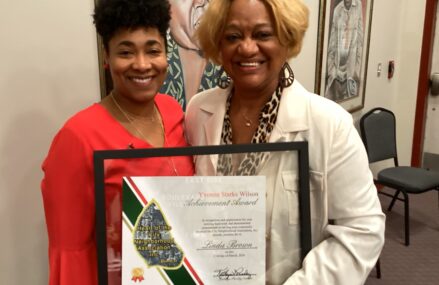
Government and politics, Municipal governments, Local governments, Accidents and disasters, General news, War and unrest, East Africa, Africa, International incidents, Rebellions and uprisings, United Nations, Armed forces, Military and defense, Explosions, Democratic Republic of the Congo, Central Africa, Rwanda, Tanzania, Peacekeeping forces
By SALEH MWANAMILONGO and JASON STRAZIUSO
Manifestantes protestan por la violencia en Goma, Congo, el sábado 24 de agosto del 2013. (Foto AP/Alain Wandimoyi)
KINSHASA, Congo (AP) — Fighting from the war in eastern Congo that pits U.N. and Congolese forces against rebels spilled over into Rwanda on Thursday when 10 shells landed in a Rwandan border town and a nearby village, killing at least one person, authorities said.
Rwanda, which the U.N. accuses of backing the rebels in the neighboring nation of Congo, blamed the Congolese military for the shelling of its territory, saying it was done with the intention of dragging them into the conflict.
Rwandan Foreign Minister Louise Mushikiwabo said a projectile fired by Congolese forces at 9:45 a.m. killed a woman and seriously injured her 2-month old baby in a market in Rubavu town, located 3 kilometers (2 miles) from the Congolese border.
“We have remained restrained for as long as we can but this provocation can no longer be tolerated. We have the capacity to determine who fired at us and will not hesitate to defend our territory. Rwanda has a responsibility to protect its population,” Mushikiwabo said. She said a second projectile landed at 11:20 a.m. in Rubavu, injuring one person, and that eight landed at nearby Busasamana village 10 minutes later.
Goma, a city of 1 million located on the Rwandan border, briefly fell to the M23 rebels last year, whose ranks are swollen with undercover Rwandan soldiers, according to repeated reports by the United Nations Group of Experts. The soldiers from Rwanda join the M23 in small groups, hiking across footpaths into Congo. Rwanda has also supplied them with arms and sophisticated equipment, including night vision goggles, the report said.
Meanwhile, combat continued in eastern Congo on Thursday, and Congolese Minister of Information Lambert Mende confirmed that two shells had landed in two separate neighborhoods in the provincial capital of Goma overnight, killing one person and wounding eight.
That brings to 13 the number of people killed in Goma by shelling from rebel positions north of the city in just over a week, ever since the Congolese army backed by United Nations troops went on the offensive against the M23 rebels.
Paluku Kavunga, a resident of Goma, said he had seen the latest victim of the shelling: “I saw the body torn into pieces of a boy who was 16 years old and who was killed last night,” he said. “This morning I heard another two detonations not far from Goma and I also saw four helicopters from the United Nations who were flying over the city of Goma.”
The fighting in recent days has been among the most intense in the past year, and comes after the United Nations Security Council in March authorized the creation of a special intervention brigade which, unlike the other 17,000 peacekeepers stationed in this vast nation, have a mandate allowing them to go on the offensive against the M23 rebel group. The brigade, made up of soldiers from Tanzania and South Africa, was created in the wake of the criticism following the fall of Goma to the rebels last year.
Reached by telephone, M23 President Bertrand Bisimwa said that the fighting had lasted until 11 p.m. on Wednesday, and resumed at 4 a.m. Thursday. He said the U.N. troops are mixed in with the Congolese soldiers.
“The Congolese and the U.N. attacked us with their infantry, with their combat tanks and with their heavy weapons,” he said. “They are mixed in together. On the front line you can see them together. We especially see the U.N. soldiers in the tanks.”
Pikkie Greeff, the national secretary of the South African National Defense Union, a military union which represents some of the soldiers fighting in Congo, said that South African Special Forces snipers have been “taking out” rebels manning machine gun posts, barriers and other positions. He also said the South African and Tanzanian troops are launching attacks from the air and hitting the rebels with artillery shells. As the fight intensifies “the possibilities of casualties are very high … and we see the possibility that soldiers might die in combat,” he said.
Congo, a nation the size of Western Europe, has been in a perpetual state of crisis for almost two decades. Even before the creation of the M23 in 2012, its forest-covered hills were crawling with other rebel groups, ethnic militias and renegade units of the regular army. The latest flare-up is causing people to flee from the very refugee camps that became their temporary homes in previous conflicts.
“Things are really bad when people are being forced to run away from displacement camps,” said Frances Charles, the Goma-based advocacy director for international aid group World Vision, who was reached by telephone. “The DRC (Democratic Republic of Congo) level of emergency is so much worse than anywhere else. What we now take as ‘normal’ would be considered a catastrophe anywhere else. For us a good day is, for another country, the biggest catastrophe they have ever seen.”
___
Jason Straziuso contributed from Nairobi, Kenya. Associated Press writers Rukmini Callimachi in Dakar, Senegal, Rodney Muhumuza in Johannesburg and Peter J. Spielmann in New York also contributed to this report.


